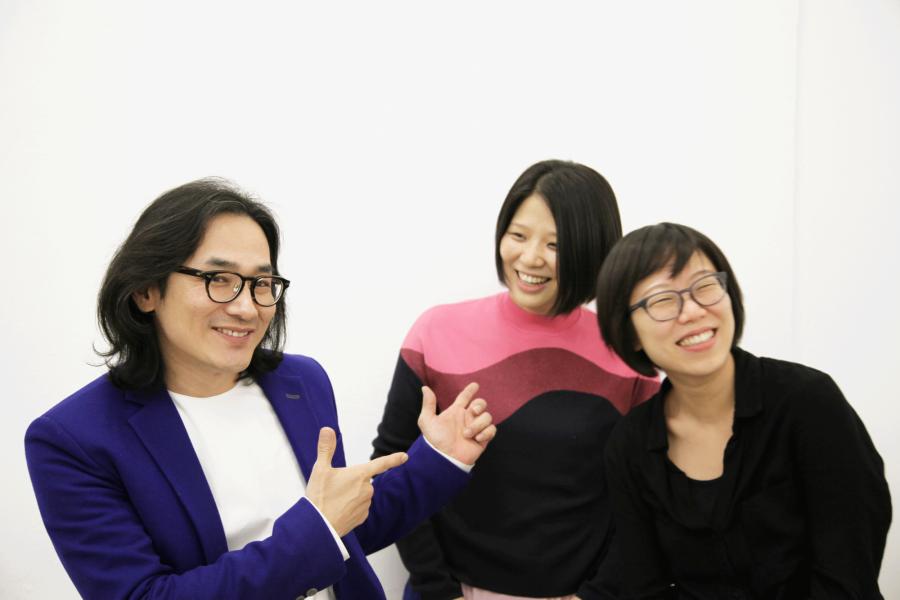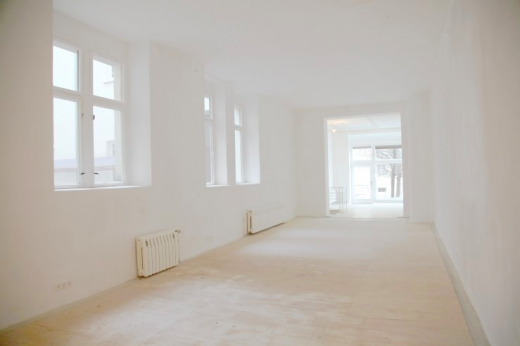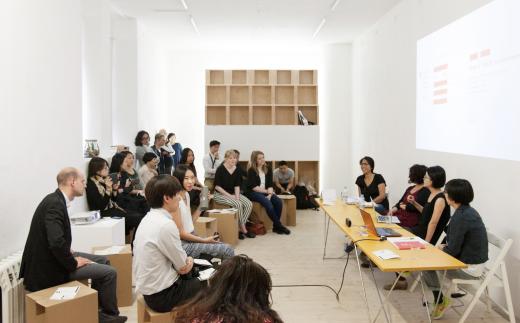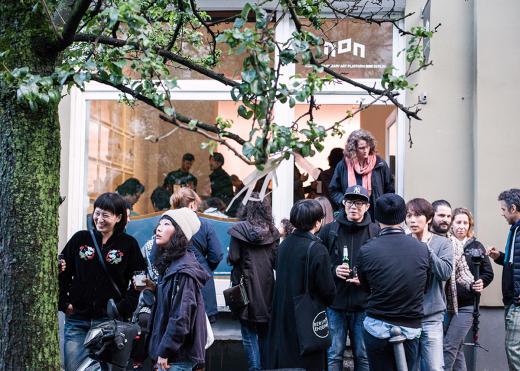Have you met... NON Berlin
Have you met... NON Berlin

Their open spirit, clean aesthetics and knowledge of both German and Asian art culture sets the Asian Art Platform NON Berlin apart from other project spaces. For NON Berlin, it is not about competing; their aim is to establish partnerships and collaborative efforts between Germany and Asia. We spoke with the people behind NON Berlin--Ido Shin, Chan Sook Choi and Nayeon Kim--to find out more about the art platform and how they work together.
For the people who do not know NON Berlin, how would you describe the concept of the platform?
Nayeon Kim: It is really hard to put it in one sentence. The aim of building this platform--why it has been established, for example--started with Ido and Chan Sook Choi. They are the two founders and I joined them almost from the beginning, in 2014. The aim was to form a bridge that would provide opportunities for Asian artists that come from Asia but live in Europe with an interest in being exposed or to be known. More than that, if you go a bit deeper, it was also about contemporary art itself. The concept of contemporary art came from Europe, but Asia shows a different perspective on that. There are so many different perspectives on Asian art itself. We want to be the platform that can generate discourse, to kind of bridge the gap and to provide more information on Asian art. We hope to influence people in a way. When Ido and Chan Sook were living and studying here they started to have a different perspective from where they come from and the so-called identity of Asia. The thing is, you never think you are Asian when you live in Asia. Suddenly, outside Asia, you are categorised as an Asian. That thought stayed in our heads and was also a motivation to build NON.
How do you work together and divide the tasks?
NYK: We all do everything. But Ido is really the machine; he never stops. All three of us throw ideas and then we discuss them. Chan Sook studied art and has another perspective. It is really great when we argue together.
CSC: Which is not always helping; sometimes I make it more complicated. I find it hard to get out of this formal form of exhibiting art that can be seen in museums and galleries. Ido and Nayeon have a different idea of how to do things. After two years I realised we cannot have any profit if we follow the same format as a museum or a gallery. We are a project space and are different from that. We have to constantly change our format. I really trust the other two members in this.
IS: Nayeon and I are more operational.
CSC Nayeon is doing the research and the project management.
NYK: Ido brings in the concept, the big frame, and we talk through details all together. I deal more with text, talks, moderation. Recently, Jaekyung joined as our exhibition coordinator. She is also a freelancer in the creative field and has been working with us with several projects until now. It's great to have her here. If it comes time to build something, it is done by everyone. And not to forget, Ido is really good with networking. Sometimes I wish we could duplicate ourselves and all get clones, that way we could do everything. Last year it was like, okay we do Asian Art Show, Project Space Festival and communicating between different channels in Hong Kong, Korea and Japan. Luckily it is not only us four now. We had and have wonderful interns, great curators working together with us and friends also.

© NON Berlin
When it comes to organising a project, how do you choose the project or collaborations you work with?
CSC: We have a curatorial team that comprises different types of curators, philosophers, art historians.
NYK: We are more focused on the exchange and exchanging ideas to generate a discourse. We are always exchanging ideas from the beginning. It never is one way. The process itself is very exciting. We have partner project spaces, for example Meinblau. We are in a good relationship with them and we really enjoy working with them. There is also Kule. It is amazing that they are so close; we are in the same area but we are so different. Of course we are not focused on our 'Kiez' only. We would love to expand our network to different areas. The most interesting part about collaborating with different project spaces is how they organize their space. Meinblau and Kule already have a long history and found their own way of doing. The whole process of starting these collaborations was quite organic. When we started talking and exchanging dialogues we were like, okay let’s do it together. It was quite an organic process, which resulted in a very good partnership.
How does the German art culture differ from the Asian art culture?
NYK: This question we get a lot. The thing is we are in Berlin, in Germany, but it doesn’t really represent Germany, I think. It is really hard to compare Germany and the whole continent of Asia.
CSC: If we say it is between Europe and Asia, I think the art market is quite different. Asia just grew up in a very short time due to the industrialisation process. A lot of artists work on issues such as the historical and social impact of industrialisation. The European art scene is more established than Asia, because Asia is changing fast. In Asia we learn about European history; we know where each country is, which modern philosophers existed. Not all Europeans learn this about Asia. It is the time to know each other deeper, to get to know each other better. We try this by bringing in Asian artists that show the Asian history and their background through their work.
NYK: It was one of the reason why Chan Sook and Ido wanted to start this space. This is also why the curatorial part is so important. To give the art more context.
CSC: The Asian art market is really growing up. There are many opportunities for European artists in Asia. This is why many European artists want to go to Asia. Korea, for example, is a small market, in which you can get direct feedback. But as an artist, it is very hard to work in Korea. Asia in general is very competitive. You get fast feedback, get things done very quickly. Sometimes you need some slow time, to focus on your artwork. Compared to Berlin, it can be very challenging. It is an ongoing question: How do we balance time?

Asian Art Talk Show 'What is "Asia" in Contemporary Art' © NON Berlin
While running an art space, what troubles do you run into?
All three: Financial issues.
NYK: Let’s imagine, if our financial issues are solved what would be the next challenge? For me it would be organising the network, making a harmonious platform, because Asia is so big. We eventually have to choose what to present. Which theme we have to focus on constantly needs to be discussed. This requires a lot of research; we need to find collaborative team members or partners who really want to work on this together. I always imagined, what if all our financial worries are gone. Then what? Then I think it will be really about expanding, trying to find the right people to collaborate with.
IS: Personally, I want to try to create an Asian community here in Berlin. We are looking for curators to work with, also from Europe. I want to create an exchange program with the Asian and European culture. We have the opportunity to send two curators from here to Korea with the cultural foundation of Korea, but they only support the atelier.
NYK: It is really amazing how many curators are still interested in this even though it is not 100% funded. They are excited about the opportunity even though they do not have all the information. This is a good sign that they really want to go there. We hope we can give them the information they need so that they can go there and bring back their broadened experience.
CSC: The cultural foundation of Korea offers a great network; it is a good opportunity.
NYK: We hope that this can happen not only in Korea but also in different areas. For us, another important thing we also need to establish, is a stronger network within Berlin. It is better if you have more people on board. We do meet a lot of people but I personally think that a lot of people in Berlin are so busy. It is not easy to find a right time to sit down and discuss things.
CSC: We are open to a lot of different opportunities in Berlin through partnerships and we also get requests from other countries. These partnerships can apply for funding in their own country, which might give us more possibilities so that we can really expand.
How do you choose to expand your network?
NYK: One thing we tried last year and we want to do again is the Asian Art show. We brought together contemporary Asian artists from 7 countries to give an exclusive spotlight on Asian contemporary artists. We did a lot of studio visits, talked with the artists about which work they would show. We really wanted a diverse group, with the hope of expanding our network. It was amazing, because for every show an average of 60 people came to see it. Every time the art changed there was a different group of people and they started talking and sharing ideas. It was really beautiful for us to see this. We want to create a long lasting relationship through talks, through gatherings. It is a repetition. Also important is to not forget with whom we worked; we need to keep in touch. I think this is very crucial.
IS: The Asian Art show was really good for networking. Our aim is to connect the European art scene with the Asian community. We want to show one community to the other. This was a very successful part of the Asian Art Show.
NYK: I think we already have a network and I think we should bring more people in. I am very interested in organizing talks, maybe due to my study. In New York, for example, there is an Asian art society and we have an Asian art show every year. You cannot create this in Berlin; New York is bigger than Berlin. But it would be interesting to find something that fits within the European art scene. The thing is that Berlin itself is becoming more known in Asia. It is really good timing.

© Non Berlin
Where do you see yourself in five years?
CSC: For me, personally I want to research my Asian cultural roots. Not just the territory. Something that we also share--it is not only about borders. All these cultural influences that we might have, that we might not even be aware of. I really want to make a platform for Asian artists. I want to do more research about my identity. Many artists came here to study and adapt. I was asked many questions about Asia and the Asian culture. I adapted here. I have to find my origin and identity so that I can represent Asia as an artist.
NYK: It is one of the things that is really interesting about artists. Many artists come here and start thinking, if I want to be an international artist I have to change and have to adapt myself to this certain mind set. This is something that a lot of people in the art scene struggle with.
IS: In five years, I hope to mobilise more inter-media projects. This year, I want to focus on the Asian diaspora with talks and discussions like in our lecture, Non Da. I don’t want to make a formal format. I want some crazy ideas. Through inter-media projects, I want to show the Asian culture and Asian art. That can be through sound installations or performances. I want to make some simple but crazy ideas.
NYK: Basically, NON Berlin was made because we wanted to do something that we want to do. It is not about big projects that make big noise. For the next years, I would like to try to focus on small but strong ties, aiming for big impact. We are inside so many fields as Ido mentioned. The form is not really the limit for us. That means that there are many projects we can do and many people we can work with. In five years, in my imagination, I would say I see NON Berlin as the center point or hub where the artists come to meet each other, but also exchange this different point of view. Also, I aim for a lot of talks because all artists are already related to the historical, the cultural, the political in a way that somehow influences oneself. These topics can be infinite.
CSC: Most importantly, the team members have to be happy, otherwise it doesn’t make sense.
NYK: We are always looking for more people who can join the platform. Basically, we are all freelancers. It is the best part of being a project space--you have the freedom to define yourself.
* * * * *
NON Berlin
Chausseestrasse 11 / Entrance Tiekstrasse
More info on website